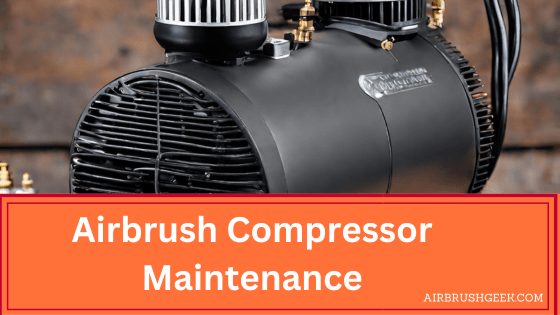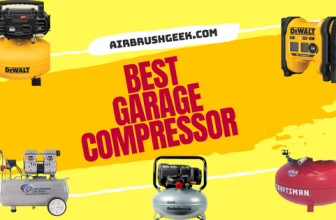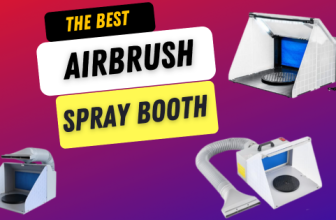Airbrush Compressor Maintenance

Have you ever had a frustrating experience with your airbrush compressor suddenly giving up on you in the middle of an art project? Trust me, I’ve been there too, and it can be quite a buzzkill. But fear not, because in this blog post, we’ll be diving into the world of airbrush compressor maintenance. We’ll explore why it’s so crucial to take care of your compressor and share some invaluable tips and tricks to ensure it stays in tip-top shape. So, grab a cup of coffee, sit back, and let’s get started on this maintenance journey together!
Discover the top-rated airbrush compressors that artists can’t stop raving about!
What is an Airbrush Compressor?
An airbrush compressor is a device that provides the necessary air pressure to operate an airbrush. It is an essential tool for artists, hobbyists, and professionals who use airbrushing techniques in their work. In this section, we will explore the different aspects of an airbrush compressor, including its functionality and the various types available in the market.
make sure you you check out my Airbrush compressor buyer’s guide that will help you choose the best airbrush compressor.
How does an Airbrush Compressor Work?
An airbrush compressor works by compressing air and delivering it to the airbrush through a hose. The compressor draws in atmospheric air and pressurizes it, creating a continuous stream of air that is then regulated by the airbrush itself. The pressure can be adjusted to achieve different effects, such as fine lines or broad coverage, depending on the artist’s requirements.
Types of Airbrush Compressors
There are several types of airbrush compressors available, each with its own set of features and benefits. Here are some popular options:
- Piston Compressors: Piston compressors are common among airbrush artists due to their reliability and versatility. They use a piston-driven mechanism to compress air and provide consistent pressure. These compressors are suitable for a wide range of applications and can handle both small and large projects.
- Diaphragm Compressors: Diaphragm compressors are known for their quiet operation and portability. They utilize a diaphragm to compress air, making them ideal for artists who work in noise-sensitive environments or require a compressor that can be easily transported.
- Tankless Compressors: Tankless compressors, as the name suggests, do not have an air storage tank. Instead, they provide a continuous airflow directly to the airbrush. These compressors are compact and lightweight, making them a popular choice for artists on the go.
- Tank Compressors: Tank compressors feature an air storage tank, which allows for a more consistent and even airflow. The tank stores compressed air, reducing the strain on the compressor motor and ensuring a steady output. Artists who require a constant and uninterrupted supply of air often opt for tank compressors.
Key Considerations when Choosing an Airbrush Compressor
When selecting an airbrush compressor, it’s important to keep the following factors in mind:
- Air Pressure: Consider the required air pressure for your specific airbrushing needs. Different airbrushes have different pressure requirements, so ensure that the compressor you choose can deliver the necessary pressure.
- Noise Level: If noise is a concern, opt for a compressor with quieter operation. Diaphragm compressors are generally quieter compared to piston compressors.
- Portability: If you frequently travel or work in different locations, choose a compressor that is lightweight and easy to transport, such as a tankless or diaphragm compressor.
- Capacity: If you anticipate working on larger projects, a compressor with a larger air storage tank might be beneficial as it provides a more consistent airflow.
- Budget: Consider your budget and look for a compressor that offers a good balance between features and affordability.
Why is Airbrush Compressor Maintenance important?
Welcome to our blog section where we will discuss the significance of regular maintenance for your airbrush compressor. In this article, we will explore the potential problems that can arise from neglecting maintenance and the benefits of keeping your compressor clean and well-maintained. By the end, you’ll understand why maintenance is crucial for the longevity and performance of your airbrush compressor.
Potential Problems from Neglecting Airbrush Compressor Maintenance
Decreased Performance
One of the key problems that can occur when you neglect maintenance is a decrease in the performance of your airbrush compressor. Over time, dirt, dust, and other debris can accumulate in the compressor, leading to clogged filters, reduced airflow, and compromised spray quality. This can result in uneven spraying patterns, inconsistent paint distribution, and an overall frustrating airbrushing experience.
Increased Wear and Tear
Without regular maintenance, your compressor may experience increased wear and tear. The internal components, such as the motor, bearings, and seals, can become strained and damaged due to the buildup of debris. This can lead to overheating, reduced efficiency, and even complete compressor failure. By taking the time to maintain your airbrush compressor, you can help prevent such issues and prolong its lifespan.
Contamination Risks
Another important aspect of maintenance is ensuring that your airbrush compressor remains clean and free from contaminants. If left unchecked, bacteria, mold, and other harmful microorganisms can grow inside the compressor, especially in areas with high humidity. These contaminants can then be transferred to your paint, resulting in poor quality finishes and potential health hazards. Regular cleaning and maintenance can mitigate these risks and ensure that you’re working with a clean and safe environment.
Benefits of Regular Airbrush Compressor Maintenance
Improved Efficiency
One of the key benefits of regular maintenance is improved efficiency. By keeping your airbrush compressor clean and well-maintained, it can operate at its optimal performance level. This means that it will consume less energy, produce less noise, and provide consistent airflow for a superior airbrushing experience. You’ll be able to achieve smoother gradients, sharper lines, and more accurate details in your artwork.
Prolonged Lifespan
Investing in regular maintenance for your airbrush compressor can significantly extend its lifespan. By addressing minor issues early on, you can prevent them from escalating into major problems that could render your compressor unusable. With proper care and maintenance, you can enjoy many years of reliable service from your compressor, saving you money in the long run.
Cost Savings
Maintaining your airbrush compressor can also lead to cost savings. By regularly cleaning and replacing filters, you can prevent expensive repairs or the need to replace the entire compressor. Additionally, a well-maintained compressor operates more efficiently, resulting in lower energy consumption and reduced utility bills. By taking the time for maintenance, you’re making a smart investment in the longevity and cost-effectiveness of your airbrushing equipment.
Airbrush compressor Maintenance tips and best practices
Taking proper care of your airbrush compressor is essential for maintaining its performance and ensuring its longevity. In this blog post, we will provide you with practical tips and best practices to help you keep your compressor in optimal condition. Whether you are a beginner or an experienced user, these maintenance steps will guide you through the process of cleaning, lubrication, and general upkeep of your airbrush compressor.

Cleaning Your Airbrush Compressor
Regular cleaning is crucial to prevent buildup of dirt, debris, and moisture that can affect the performance of your compressor. Follow these steps to keep it clean:
- Disconnect the compressor: Before starting any cleaning procedure, make sure to disconnect the compressor from the power source to avoid any accidents.
- Remove the air filter: The air filter is responsible for removing dust and particles from the air before it enters the compressor. Remove the filter and clean it using a mild detergent and warm water. Allow it to dry completely before reattaching it.
- Clean the exterior: Wipe down the exterior of the compressor with a soft cloth dampened with water or a mild cleaner. Be cautious not to wet any electrical components.
- Inspect and clean the airbrush connection: Check the airbrush connection for any dirt or debris. Use a small brush or a cotton swab to remove any buildup. Ensure that the connection is tight and secure.
Lubricating Your Airbrush Compressor
Proper lubrication helps to reduce friction and keep the moving parts of your compressor running smoothly. Follow these guidelines to lubricate your compressor effectively:
- Refer to the manufacturer’s instructions: Different compressors may have specific lubrication requirements. Consult the user manual for your compressor to determine the recommended lubrication interval and type of oil to use.
- Apply lubricant to moving parts: Some compressors have visible moving parts that require lubrication, such as pistons or bearings. Apply a small amount of recommended oil to these parts following the manufacturer’s instructions.
- Avoid over-lubrication: Using too much oil can lead to clogging or damage to the compressor. Apply only the recommended amount to ensure proper lubrication.
General Airbrush Compressor Maintenance Tips
In addition to cleaning and lubrication, here are some general maintenance tips to ensure optimal performance of your airbrush compressor:
- Check for air leaks: Periodically inspect the hoses, fittings, and connections for any signs of leakage. Tighten or replace any parts as necessary.
- Monitor pressure and temperature: Keep an eye on the pressure gauge and ensure that it stays within the recommended range. Excessive pressure or overheating can lead to compressor damage.
- Store properly: When not in use, store your compressor in a clean, dry area away from dust or moisture. Use a protective cover if possible.
- Follow maintenance schedules: Regularly refer to the manufacturer’s recommended maintenance schedule and perform any required tasks, such as replacing filters or belts.
Remember, proper maintenance is essential for the longevity and optimal performance of your airbrush compressor. By following these tips and best practices, you can ensure that your compressor remains in excellent condition for years to come.
For more information about specific maintenance procedures or recommendations for your airbrush compressor model, please refer to the manufacturer’s instructions or contact their customer support.

Troubleshooting Airbrush Compressor common issues
Airbrushing is a popular technique used by artists, hobbyists, and professionals alike to create stunning artwork. However, like any other tool, airbrush compressors can sometimes encounter issues that may hinder their performance. In this blog section, we will address some common problems that airbrush compressor owners may encounter and provide troubleshooting tips to resolve these issues. Our goal is to help you identify and fix minor problems without the need for professional assistance.
Airbrush Compressor Maintenance Issue 1: Compressor Not Turning On
Possible Causes:
- Faulty power supply or outlet
- Defective power switch
- Blown fuse
Troubleshooting Tips:
- Check the power supply: Ensure that the power outlet is working properly by plugging in another device. If the outlet is fine, move on to the next step.
- Inspect the power switch: Check if the power switch is in the “on” position and not stuck. If it seems faulty, consider replacing it.
- Check the fuse: Locate the fuse in your compressor and check if it’s blown. If so, replace it with a new one of the same rating.
Airbrush Compressor Maintenance Issue 2: Air Pressure Fluctuations
Possible Causes:
- Air leaks in the compressor or airbrush hose
- Inconsistent power supply
- Dirty or clogged air filter
Troubleshooting Tips:
- Inspect for air leaks: Apply a soapy water solution to the connections between the compressor and airbrush hose. If you notice bubbles forming, there is a leak. Tighten the connections or replace any damaged parts.
- Stable power supply: Ensure that your compressor is connected to a stable power source. Fluctuations in power can affect air pressure. Consider using a surge protector or voltage regulator to stabilize the power supply.
- Clean the air filter: Regularly clean or replace the air filter to prevent dust and debris from clogging it. A clogged filter can restrict airflow and cause pressure fluctuations.
Airbrush Compressor Maintenance Issue 3: Unusual Noise or Vibrations
Possible Causes:
- Loose parts or fittings
- Worn-out bearings or motor components
- Incorrect lubrication
Troubleshooting Tips:
- Tighten loose parts: Inspect the compressor and tighten any loose parts or fittings. Vibrations can occur when components are not securely fastened.
- Check bearings and motor: If the noise persists, it might be due to worn-out bearings or motor components. Consult your manufacturer’s guidelines for instructions on lubrication or consider contacting their customer support for assistance.
Airbrush Compressor Maintenance Issue 4: Overheating
Possible Causes:
- Extended use without breaks
- Insufficient ventilation
- Faulty thermal protection system
Troubleshooting Tips:
- Allow breaks during use: If you’ve been using the compressor for an extended period, it might be overheating. Allow it to cool down by turning it off and giving it some time to rest.
- Ensure proper ventilation: Make sure there is adequate airflow around the compressor. Avoid placing it in enclosed spaces or covering it with items that could obstruct ventilation.
- Check thermal protection system: Some compressors are equipped with a thermal protection system that automatically shuts off the compressor when it reaches a certain temperature. If your compressor is frequently overheating, consider contacting the manufacturer for further guidance.
Remember, these troubleshooting tips are meant to address common issues and provide you with guidance for resolving them. If you encounter more complex problems or if these tips don’t solve the issue, it’s always a good idea to reach out to the manufacturer’s customer support for further assistance. Happy airbrushing!
Keeping Your Airbrush Compressor in Tip-Top Shape
In conclusion, taking care of your airbrush compressor through regular maintenance is crucial. By following the guidelines discussed in this post, you can maximize its lifespan and ensure it performs at its best. Don’t forget to incorporate a maintenance routine into your airbrush compressor usage for long-lasting and optimal performance. Happy airbrushing!














I’ve been using my airbrush compressor for a while, and it’s starting to make strange noises. Any suggestions for what might be causing this?
As a guest I would say probably over heating!
I appreciate the tips on preventing moisture buildup in the compressor. Very helpful!
Is it necessary to clean the air filter regularly? How often should it be done?
I replace mine maybe twice a year, and clean them regularly!
Thank you for the article! It’s given me confidence to take better care of my airbrush compressor.
Great article! I learned a lot about maintaining airbrush compressors.
Could you provide more information about the specific maintenance steps for different types of airbrush compressors?
Do you have any recommendations for reliable airbrush compressor brands or models?
I found the troubleshooting section very useful. It helped me identify and fix a problem with my compressor.